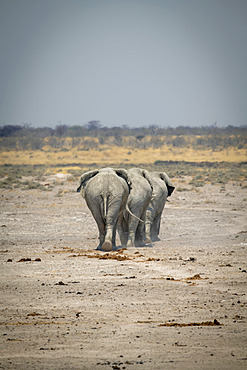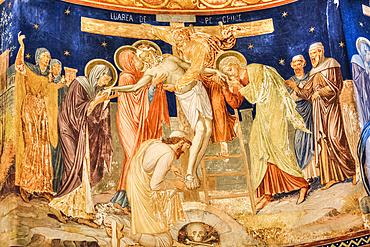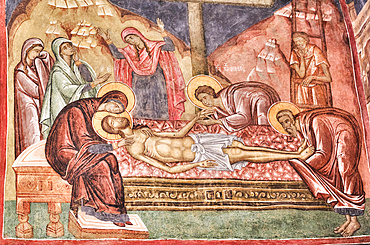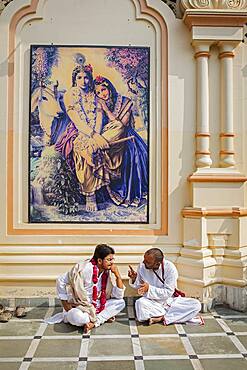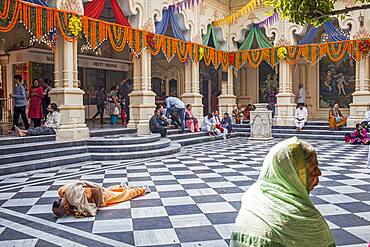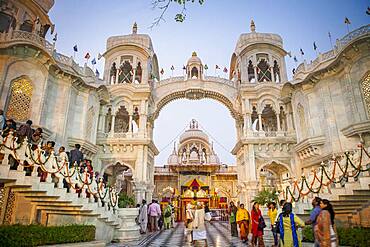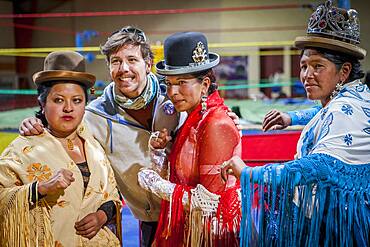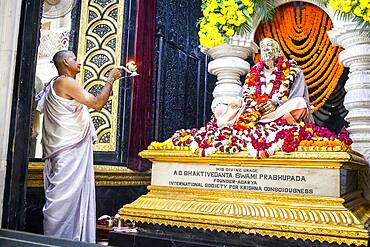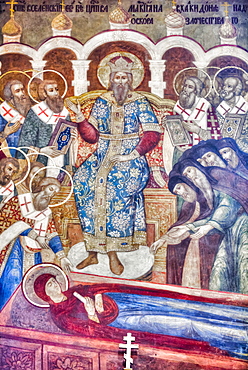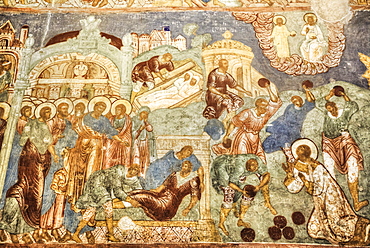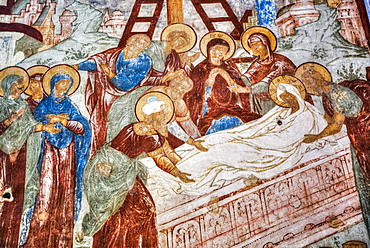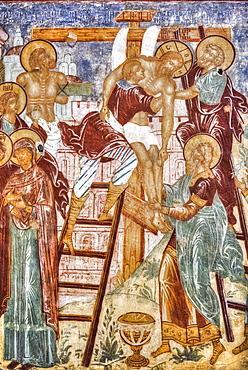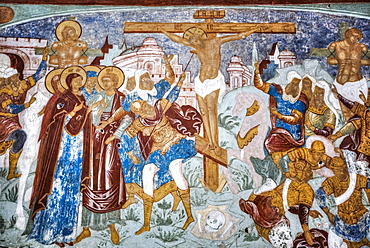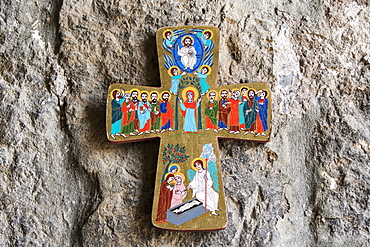Recent searches
Loading...
809-8622 - Cao Dai temple, Caodaist worshippers at ceremony, meditating followers of the Cao Dai religion, Tan Chau, Vietnam, Indochina, Southeast Asia, Asia
1116-51901 - Three African bush elephants (Loxodonta africana) cross rocky pan, Etosha National Park; Otavi, Oshikoto, Namibia
1116-51842 - Interior Fresco, St George Church Mirauti, 1375; Suceava, Suceava County, Romania
1116-51846 - Interior fresco, Church of the Holy Cross, 1487; Patrauti, Suceava County, Romania
1116-51774 - Frescoes, New St George Church, 1705, Old Town Bucharest; Bucharest, Romania
1116-51844 - Interior Fresco, St George Church Mirauti, 1375; Suceava, Suceava County, Romania
1116-51900 - Three African bush elephants (Loxodonta africana) cross rocky pan, Etosha National Park; Otavi, Oshikoto, Namibia
1116-51870 - Fresco, Holy Trinity Cathedral, founded in 1902; Sibiu, Transylvania Region, Romania
1116-51841 - Interior Fresco, St George Church Mirauti, 1375; Suceava, Suceava County, Romania
1116-51843 - Interior Fresco, St George Church Mirauti, 1375; Suceava, Suceava County, Romania
1116-51848 - Interior fresco, Church of the Holy Cross, 1487; Patrauti, Suceava County, Romania
1113-105728 - Detail shot of a Chinese, decorative key chain. Bali, Indonesia.
1113-106700 - Tractor on the beach with trailer for kite buggies- Omaha Beach, Calvados, France.
1350-1304 - Followers of the Christian sect of Fifohazana, sunday mass, Soatanana village, Madagascar
1350-1692 - Believers speaking, in ISKCON temple, Sri Krishna Balaram Mandir,Vrindavan,Mathura, Uttar Pradesh, India
1350-846 - Lucha Libre. After the show. A follower is photographed with cholitas fighters. Down Julieta, Celia la Simpatica, and Dina with blue dress , cholitas females wrestlers ,Sports center La Ceja, El Alto, La Paz, Bolivia
1350-1303 - Followers of the Christian sect of Fifohazana, sunday mass, Soatanana village, Madagascar
1350-1686 - Praying, ISKCON temple, Sri Krishna Balaram Mandir,Vrindavan,Mathura, Uttar Pradesh, India
1350-1693 - ISKCON temple, Sri Krishna Balaram Mandir,Vrindavan,Mathura, Uttar Pradesh, India
1350-1691 - Group of women praying, in ISKCON temple, Sri Krishna Balaram Mandir,Vrindavan,Mathura, Uttar Pradesh, India
1350-845 - Lucha Libre. After the show. A follower is photographed with cholitas fighters. At left Julieta, in the middle Celia la Simpatica, and Dina , cholitas females wrestlers ,Sports center La Ceja, El Alto, La Paz, Bolivia
1350-1302 - Followers of the Christian sect of Fifohazana, sunday mass, Soatanana village, Madagascar
1350-1687 - Praying, ISKCON temple, Sri Krishna Balaram Mandir,Vrindavan,Mathura, Uttar Pradesh, India
1350-1305 - Followers of the Christian sect of Fifohazana, sunday mass, Soatanana village, Madagascar
1350-1688 - Praying, ISKCON temple, Sri Krishna Balaram Mandir,Vrindavan,Mathura, Uttar Pradesh, India
1350-1689 - Praying, statue of A. C. Bhakivedanta Swami Prabhupada the founder of hare Krishna movement, in ISKCON temple, Sri Krishna Balaram Mandir,Vrindavan,Mathura, Uttar Pradesh, India
1350-1690 - Group of women praying, in ISKCON temple, Sri Krishna Balaram Mandir,Vrindavan,Mathura, Uttar Pradesh, India
805-557 - Monk, follower of Mahima Dharma sect, wearing orange loincloth carrying brass pots of water into the temple at sunset, Joranda, Orissa, India, Asia
1116-49984 - Fresco, Holy Formation Cathedral, Trinity Sergius Lavra Monastery complex; Sergiev Posad, Moscow Oblast, Russia
1116-50023 - Fresco in the Church of St John the Baptist; Yaroslavl, Yaroslavl Oblast, Russia
1116-50166 - Fresco, Transfiguration Cathedral, Monastery of St Euthymius; Suzdal, Vladimir Oblast, Russia
1116-50157 - Fresco, Miracle-Image of the Saviour Church, Kremlin, Golden Ring; Rostov Veliky, Yaroslavl Oblast, Russia
1116-50185 - Fresco, The Resurrection Church on the Debra; Kostroma, Kostroma Oblast, Russia
1116-50013 - Church of Elijah the Prophet, with colourful frescoes on the walls depicting Biblical scenes; Yaroslavl, Yaroslavl Oblast, Russia
1116-50385 - Female cheetah (Acinonyx jubatus) crosses grassland with two cubs, Grumeti Serengeti Tented Camp, Serengeti National Park; Tanzania
1116-50186 - Fresco, Troitse-Sergiyev Varnitskiy Monastery, near Rostov Veliky, Golden Ring; Yaroslavl Oblast, Russia
1116-50026 - Fresco in the Church of St John the Baptist; Yaroslavl, Yaroslavl Oblast, Russia
1116-50025 - Fresco in the Church of St John the Baptist; Yaroslavl, Yaroslavl Oblast, Russia
1116-50161 - Fresco, Gate Church of the Resurrection (1670), Kremlin, Golden Ring; Rostov Veliky, Yaroslavl Oblast, Russia
1116-50027 - Fresco in the Church of St John the Baptist; Yaroslavl, Yaroslavl Oblast, Russia
1116-50184 - Fresco, The Resurrection Church on the Debra; Kostroma, Kostroma Oblast, Russia
1116-50019 - Church of Elijah the Prophet, with ornate arched doorways and colourful frescoes; Yaroslavl, Yaroslavl Oblast, Russia
1116-49985 - Fresco, Holy Formation Cathedral, Trinity Sergius Lavra Monastery complex; Sergiev Posad, Moscow Oblast, Russia
1116-50020 - Church of Elijah the Prophet, with ornate arched doorway and colourful frescoes; Yaroslavl, Yaroslavl Oblast, Russia
1116-50015 - Church of Elijah the Prophet, with colourful frescoes on the walls depicting Biblical scenes; Yaroslavl, Yaroslavl Oblast, Russia
1116-50162 - Fresco, Gate-Church of the Resurrection (1670), Kremlin, Golden Ring; Rostov Veliky, Yaroslavl Oblast, Russia
1116-50187 - Interior Fresco, Cathedral of the Nativity (1222), Kremlin; Suzdal, Vladimir Oblast, Russia
1116-50160 - Fresco, Gate Church of the Resurrection (1670), Kremlin, Golden Ring; Rostov Veliky, Yaroslavl Oblast, Russia
1116-50014 - Church of Elijah the Prophet, with colourful frescoes on the walls depicting Biblical scenes; Yaroslavl, Yaroslavl Oblast, Russia
1116-48069 - Fresco, Holy Dormition Cathedral, The Holy Trinity Saint Serguis Lavra, Sergiev Posad, Sergiyevo-Posadsky District, Moscow Oblast, Russia
1116-47575 - American Flamingos (Phoenicopterus ruber) flying in a V formation, Celestun Biosphere Reserve, Celestun, Yucatan, Mexico
1116-46254 - Cross With Paintings Depicting The Life Of Jesus At Khor Virap Monastery, Ararat Province, Armenia
1116-43891 - Young Disabled Woman Sitting Beside Her Wheelchair In A City Park In Autumn, Edmonton, Alberta, Canada
1116-43103 - Statues Of Jesus Christ On The Cross And Followers At The Foot Of The Cross, County Kerry, Ireland
805-1243 - Monks at Joranda Gadhi, a temple complex devoted to the Supreme Lord for followers of Mahima dharma, Dhenkanal, Odisha, India, Asia
805-1244 - Worshippers at Joranda Gadhi, a temple complex devoted to the Supreme Lord for followers of Mahima dharma, Dhenkanal, Odisha, India, Asia
1116-41434 - Elephants Walking In A Row, Samburu, Kenya
809-7414 - Fresco depicting the Buddha with followers in Wat Chiang Mun, Chiang Mai, Thailand, Southeast Asia, Asia
832-378678 - Mass event at Wat Phra Dhammakaya temple, followers holding pictures with Buddha images, Khlong Luang District, Pathum Thani, Bangkok, Thailand, Asia *** IMPORTANT: Image must not be used in a negative context with the Dhammakaya temple ***
911-10458 - A traditional Hindu village festival near Bangalore, Karnataka, India.
832-370805 - Yamabushi follower, mountain ascetics, Buddhist sect, priest invoking the deity at the fire, Iwakura, Japan, East Asia, Asia
1161-4482 - Sri Lankan Buddhist visitors at Dhamakh Stupa at Sarnath ruins near Varanasi, Benares, Northern India
1161-4489 - Buddhist monks pass prayer flags at Mulagandhakuti Vihara Temple at Sarnath near Varanasi, Benares, Northern India
1161-6785 - Priest carries Blessed Sacrament in Corpus Christi catholic traditional Benediction ceremony in Clifden, County Galway, Ireland
1161-4484 - Buddhist monk praying as he walks around Dhamakh Stupa at Sarnath ruins near Varanasi, Benares, Northern India
1161-4483 - Buddhist visitors applying gold leaf as traditional offering at Dhamakh Stupa at Sarnath ruins near Varanasi, Benares, Northern India
1161-4481 - Buddhist monks visiting Dharmarajika Stupa at Sarnath ruins near Varanasi, Benares, Northern India
1161-4487 - Buddhist monk passes prayer flags at Mulagandhakuti Vihara Temple at Sarnath near Varanasi, Benares, Northern India
1161-4486 - Buddhist monk at Sri Lankan Buddhist Temple, Mulagandhakuti Vihara, near Varanasi, Benares, Northern India
1161-4530 - Indian man and woman walking along Rana Mahal Ghat by the Ganges River in City of Varanasi, Benares, Northern India
1161-4485 - Lighted candles offering Buddhist prayers at Dharmarajika Stupa at Sarnath near Varanasi, Northern India
832-204897 - Yamabushi followers, mountain ascetics, Buddhist sect, pushing cedar branches off the fire with bamboo poles, Iwakura, Japan, East Asia, Asia
817-416249 - Elderly woman with basket of sticky rice for monks Luang Prabang Laos PDR
817-416248 - Barefoot monks collecting food and drink alms early morning Luang Prabang Laos
817-416247 - Barefoot monks collecting food and drink alms early morning Luang Prabang Laos
817-416246 - Barefoot monks collecting food and drink alms early morning Luang Prabang Laos
1113-71614 - Prayers and offering from religious followers, Azure Clouds Temple, Mount Tai, Tai Shan, Shandong province, World Heritage, UNESCO, China
1116-11271 - Thanksgiving plaques on a shrine at the Difunta Correa Sanctuary, Vallecito, San Juan, Argentina. La Difunta Correa is the most popular of Argentina's folk saints. She was a woman whose husband was forcibly recruited around the year 1840, during the Argentine civil wars. Becoming sick, he was then abandoned by partisans. In an attempt to reach her sick husband, Deolinda took her baby and followed the tracks of the partisans through the desert of San Juan Province. When her supplies ran out, she died. Her body was found days later by gauchos, however they found the baby still alive, feeding from the deceased woman's miraculously ever-full breast. Once the folk tale became known, her devout followers believe her to perform miracles and intercede for the living. Cattle keepers and truck drivers create small altars throughout Argentina and leave bottles of water as votive offerings.
1116-11272 - Thanksgiving plaques on a shrine at the Difunta Correa Sanctuary, Vallecito, San Juan, Argentina. La Difunta Correa is the most popular of Argentina's folk saints. She was a woman whose husband was forcibly recruited around the year 1840, during the Argentine civil wars. Becoming sick, he was then abandoned by partisans. In an attempt to reach her sick husband, Deolinda took her baby and followed the tracks of the partisans through the desert of San Juan Province. When her supplies ran out, she died. Her body was found days later by gauchos, however they found the baby still alive, feeding from the deceased woman's miraculously ever-full breast. Once the folk tale became known, her devout followers believe her to perform miracles and intercede for the living. Cattle keepers and truck drivers create small altars throughout Argentina and leave bottles of water as votive offerings.
857-68216 - Every Friday dervishes gather an hour before sunset in front of Sheikh Hamed al-Nil tomb in Omdurman, Sudan to perform a ritual called Zikr (Dhikr). The ceremony starts chanting words of gratitude to the Prophet Mohammed. The audience interacts with the chanters, dancing to the rhythms of the percussion instruments. The dervishes start whirling around. The music, the fragrance of burning incense, the endless repetition of religious chants creates a state of ecstasy, a kind of trance in which human soul is believed to communicate directly with God.
857-68209 - Every Friday dervishes gather an hour before sunset in front of Sheikh Hamed al-Nil tomb in Omdurman, Sudan to perform a ritual called Zikr (Dhikr). The ceremony starts chanting words of gratitude to the Prophet Mohammed. The audience interacts with the chanters, dancing to the rhythms of the percussion instruments. The dervishes start whirling around. The music, the fragrance of burning incense, the endless repetition of religious chants creates a state of ecstasy, a kind of trance in which human soul is believed to communicate directly with God.
857-35187 - Mayan indian religous men at Easter Procession in Antigua.
1196-86 - Trulshig rinpoche, blesses. Tulshig rinpoche blesses. Tulshig rimpoche s followers believe that he, like many other lamas, reassumes a human body after death in order to return to disciples. previous incarnation of tulshig rimpoche spent several years at dzarongpu monastery (highest monastery in world located at 16,500’ within sight of northern side of mt everest) served as of ngawong tenzin teachers. He promised to return in next life, so at tulshig s death ngawong tenzin norbu sought found reincarnation. current tulshig rimpoche then came to monastery studied with ngawong tenzin norbu. relationship between teacher student, in which a teacher returns to study from former student, maintains lineage over generations. Bhutan
1196-165 - Forehead designs, called tilakas, show a sadhus religious sectarian affiliations range from a simple daub of color to complex designs involving entire face. Vertical design of this sadhus tilaka shows to be a vaishnava, or follower of vishnu, preserver of universe. He is a benevolent gentle. gentility is reflected in worshippers devotess. application of a tilaka is usually done at start of each after bathing as a to sanctify body prepare it to receive divine. India
920-811 - Falungong (Falun Dafa) follower, jacket detail, Geoje-Do, South Korea, Asia
911-3109 - England football fans celebrate a goal in the World Cup
911-3105 - England football fans celebrate a goal in the World Cup
817-272981 - Tangsa Man, Lungchang Tribe at Namdapha Eco Cultural Festival, Miao, Arunachal Pradesh, India
817-272978 - Nocte warrior tribes, with traditional Wear performing dance at Namdapha Eco Cultural Festival, Miao, Arunachal Pradesh, India
817-200389 - Portrait of an Indian Sadhu (holy man): sadhus have different markings on their forehead, horizontal lines identify this Sadhu as a Shiva Hindu god follower
817-225717 - A holy man in a street, Pink City, Jaipur, Rajasthan, India
817-200859 - An Indian Sadhu holy man with very long rasta style dreadlock hair
817-200866 - An Indian Sadhu holy man with very long rasta style dreadlock hair
817-200860 - An Indian Naga Sadhu naked with an iron belt
817-200856 - An Indian Sadhu holy man with very long rasta style dreadlock hair
817-200867 - An Indian Sadhu holy man with very long rasta style dreadlock hair




